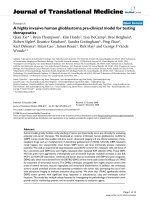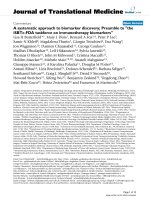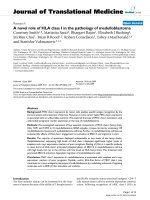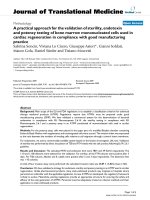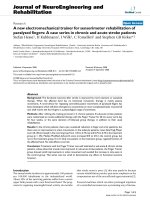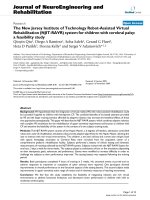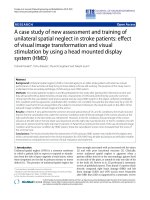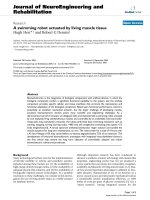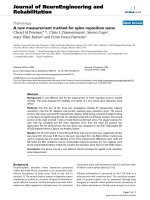Báo cáo hóa học: "A new time-hopping/direct-sequence biorthogonal PPM UWB communication system" docx
Bạn đang xem bản rút gọn của tài liệu. Xem và tải ngay bản đầy đủ của tài liệu tại đây (2.63 MB, 11 trang )
RESEARCH Open Access
A new time-hopping/direct-sequence
biorthogonal PPM UWB communication system
Ye-Shun Shen
1
, Fang-Biau Ueng
2
and Li-Der Jeng
3*
Abstract
In order to increase the capacity and diminish the multiple access interference (MAI) of an ultra-wideband (UWB)
system, we propose a new time-hopping/direct-sequence (TH/DS) scheme using N-ary biorthogonal pulse position
modulation (BPPM). In contrast with the conventional TH/DS systems employing fixed partition of the TH slots
(Shen and Ueng, Proceedings of the IEEE VTC-Spring, 2010), the proposed TH/DS system can put the start location
of the TH slot in any one of Q available pulse positions within the frame. In the proposed TH/DS system, the
modulation level of BPPM can be increased and the multiple access capability can be improved without degrading
the system performance. Compared with the existing TH-UWB system that employs the whole frame to carry out
TH process (Shen et al. IEEE Trans. Veh. Technol. 59(2), 742-753, 2010), the proposed system has the merits of
smooth power spectral density and low receiver complexity. In this article, we also derive the probability
distribution of MAI for each correlator’s output of the proposed TH/DS system based on the analytic characteristic
function technique. In order to verify the correctness of the performance analyses and to demonstrate the
effectiveness of the proposed TH/DS system, some simulation results are given in both the additive white Gaussian
noise channel and the realistic UWB fading chann els. From the simulation results, we find that the proposed TH/DS
system outperforms the conventional TH/DS scheme.
Keywords: characteristic funct ion (CF), time-hopping (TH), ultra-wideband (UWB), multiple access interference (MAI)
1 Introduction
Owing to the demand of short-range high-speed wireless
data communication, the impulse radio ultra-wideband
(IR-UWB) transmission which transmits extremely short
impulses (referred to as monocycles) becomes an attrac-
tive technology recently [1]. The high ratio of trans-
mitted signal bandwidth to data signal bandwidth makes
UWB technique useful for multiple access applications.
The modulation schemes that consist of pulse amplitude
modulation (PAM), pulse position modulation (PPM),
and pulse position amplitude modulation (PPAM) a re
widely adopted in IR-UWB systems. PPM and PAM
modulations use the precise position and amplitude of
impulses, respectively, to convey data message, while
PPAM exploits both the position and amplitude of
mono-cycle to carry information. N(= 2M)-ary biortho-
gonal PPM (BPPM) which combines binary PAM and
M-ary PPM is a special case of PPAM. Under the same
throughput, N-ary BPPM can provide better perfor-
mance and less complexity than those of M-ary PPM
[2,3].
The time-hopping (TH) and direct sequence (DS)
multiple access schemes are applied in IR-UWB systems.
In the conventional TH UWB system, each symbol
duration is divided into N
s
frames, and each frame inter-
val is divided into N
c
time slots (chips). A data symbol is
modulated based on the adopted modulation scheme to
transmit one pulse in each frame duration. Afterward,
the position of the time slot in each frame on which the
modulated pulse is located is selected and hopped from
frame to frame according to the pseudorandom TH
code. However, the use of PPM and/or PAM signaling
in conventional TH system has one disadvantage that
the line spectral occurs in the spectrum of the trans-
mitted signals. This is because the same polarity (unipo-
lar) of monocycles are transmitted in a given symbol
period. To alleviate the effect of this problem, the con-
ventional TH systems exploiting the randomized polarity
* Correspondence:
3
Department of Electronic Engineering, Chung-Yuan Christian University,
Chung Li, Taiwan
Full list of author information is available at the end of the article
Shen et al. EURASIP Journal on Wireless Communications and Networking 2011, 2011:149
/>© 2011 Shen et al; licensee Springer. This is an Open Access article dist ributed under the terms of the Creativ e Commons Attribution
License ( which permits unrestricted use, distribution, and reproduction in any medium,
provided the original work is properly cited .
(bipolar) of the transmitted pulses, also called the hybrid
TH/DS system, are studied in [3,4]. The selections of
the user-specific TH codes, corresponding to the utilized
time slots, and the polarity (DS) codes are well designed
to mitigate the multiple access interference (MAI) and
improve the system capability.
In Figure 1, all of the users transmit their signals in
the same symbol period. The matrix representations of
Figure 1 The matrix representations of hopping and dehopping processes for (a) the conventional TH/DS and (b) the proposed TH/DS
systems.
Shen et al. EURASIP Journal on Wireless Communications and Networking 2011, 2011:149
/>Page 2 of 11
the TH and dehopping processes are carried out in a
deterministic manner. A drawback of the conventional
TH system is that the greater the modulation level of
the N-ary BPPM or the number of frame
(
N
s
)
is, the
fewer the number of the provided TH slots
(
N
c
)
becomes. In this article, a flexible TH scheme that
employs the whole frame duration to carry out TH is
proposed. In the proposed system, each symbol duration
is divided into N
s
frames, but each frame i nterval is par-
titioned into Q pulse slots. Specifically, ea ch user is
assigned a random TH code such that the first pulse
position of a TH slot can be located to any one of Q
available pulse slots within one frame. Therefore, the
MAI in the proposed system is hardly produced from
the same interfering user’s signal because of the ran-
domness location of the transmitted pulses within each
used TH slot. However, in the conventional TH scheme,
the MAI that leads to an erroneous symbol detection i s
often produced from the same interfering user’ssignal.
When the number of frame is increased to be the lar-
gest, then the number of TH slot becomes
N
c
=1
, i.e.,
there is no TH capability to be provided in the conven-
tional system. In the same scenario, the TH capability
still exists in the proposed system. Therefore, the impact
of MAI on the system performance in the conventional
scheme is more severe than that in the proposed
scheme. Hence, irrespective of the modulation level of
BPPM, the performances of the proposed scheme is
always better than that of the conventional scheme.
In asynchronous MA environment, the collisions of
the received pulses from different users are inevitable
because of the randomness of time misalignment among
the received signals of all the users. Compared with bin-
ary modulation, it is well known that N-ary biorthogonal
modulations are able to provide higher throughput and
better BER performance, as the modulation level is
increased [5]. The benefit of the proposed TH scheme is
able to increase the modulation level of N-ary BPPM
signaling without decreasing the number of TH slots.
Consequently, the pro posed TH method employing lar-
ger modulation level can carry more information bits in
a symbol duration and then improve the system
throughput. At the transmitter of the proposed TH/DS
system, the TH-coded symbol sequence of each user is
first generated according to the specific TH code (hop-
ping pattern) and becomes as t he input of N-ary BPPM
modulator which also applies specific DS code to rando-
mize the polarity of the modulated pulses. The proposed
TH technique has been widely employed in the fre-
quency-hopping (FH) system which combines a larger
modulation level of M-ary FSK modulation and provides
better performance [6,7].
For the conventional TH-UWB systems with binary
PAM and/or PPM modulations in asynchronous MA
scenarios, the performance analyses have been exten-
sively investigated in [4,8-15]. For the convention al TH-
UWB systems with M-ary orthogonal PPM and N-ary
biorthogonal PPM modulations, some relative studies
have been reported in [16-20] and [2,21]. The Gaussian
distribution assumption can be adopted to model the
MAI statistics to derive some simple theoretical analyses
for the binary PPM, M-ary orthogonal PPM and N-ary
biorthogonal PPM signaling [2,8-10,16]. However, if we
consider the medium and high signal-to-noise ratio
(SNR) conditions, the Gaussian approximation (GA)
fails to model the statisti cs of MAI precisely
[4,11-13,18,20]. The exact expression of the cumulative
distribution function (CDF) o f the MAI is inconsistent
with that obtained by using the GA. Hence, using GA
leads to inaccurate error probability analysis and also
leads to optimistically overestimate the system perfor-
mance. By deriving the characteristic functions (CF) of
the MAI, the accurate performance analyses of binary
PPM/TH, M-ary orthogonal PPM/TH and N-ary BPPM/
TH/DS UWB systems were proposed in [3,12-14,20]. In
this article, the analytic CF expression of the MAI is
derived and the performance analyses of the proposed
TH/DS-UWB system is then obtained.
The rest of this article is organized as follows. The
conventional and the proposed TH/DS systems with N-
ary BPPM are described in Section 2. In Section 3, the
analytic expression of the probability distributions of
MAI and the average symbol error rate (SER) of the
proposed TH/DS system is derived. Some numerical
examples and discussions for the proposed system are
presentedinSection4.Finally,wegivesomeconclu-
sions in Section 5.
2 System model
In this section, the performance of the proposed TH/
DS-UWB system will be compared with that of the con-
ventional DS-UWB system and the conventional TH/DS
UWB system. The conventional DS-UWB signal can be
expressed as follows [13,14]:
s
(k)
DS
(t)=
E
b
N
r
∞
j=−∞
N
r
−1
n=0
d
(k)
j
c
(k)
n
p(t − jT
f
− nT
c
)
(1)
where
c
(k)
n
∈{1, −1}
denotes the nth chip of the kth
user’s spreading sequence; E
b
is the average bit energy;
d
(k)
j
∈{1, −1}
is the jth message bit of the kth user; and
N
r
denotes the number of chips in a bit duration. For
the conventional TH/DS system using N-ary BPPM, we
divide one symbol duration T
s
into N
s
equally spaced
Shen et al. EURASIP Journal on Wireless Communications and Networking 2011, 2011:149
/>Page 3 of 11
frames with duration T
f
, and each frame interval T
f
is
divided into N
c
equally spaced time slots (chips) with
duration T
c
. The N-ary BPPM-modulated signal is trans-
mitted and located on one of the available N
c
chips
according to the assigned TH code for each user. The
N-ary BPPM-modulated signal is the antipodal version
of the M(= N/2)-ary PPM signal. For the ith symbol per-
iod of the kth user, the N-ary BPPM signal of the con-
ventional TH/DS system can be modeled as
s
(k)
(t )=
i
(−1)
n
(k)
i
b
(k)
(t − iT
s
− m
(k)
i
δ)
(2)
where t is the time index,
m
(k)
i
∈{0, 1, 2, , M − 1}
and
n
(k)
i
∈{0, 1}
denote v - 1 bits and one bit of the ith
message symbol, respectively. Overal l,
u
(k)
i
=
m
(k)
i
, n
(k)
i
represents a v-bit message symbol and maintains the
same in the ith symbol duration. In ad dition, the signal
waveform of the kth user can be written as
b
(k)
(t )=
E
s
N
s
(i+1)N
s
−1
j=iN
s
a
(k)
j
p
t − jT
f
− c
(k)
j
T
c
(3)
where E
s
is the average symbol energy which is
assumed to be the same for all the users’ signals, N
s
is
the number of transmitted pulses required to represent
one symbol of message,
c
(k)
j
∈{0, 1, 2, , N
c
− 1}
is the
jth element of the kth user’ s TH code, and
a
(k)
j
∈{−1, 1}
is the jth element of the kth user’sran-
dom polarity code (or random DS spreading code). To
reduce the effect of MAI, it can be well designed to
assign the specific random TH code
c
(k)
=
c
(k)
0
, c
(k)
1
, , c
(k)
N
s
−1
and ran dom polarity (DS)
code
a
(k)
=
a
(k)
0
, a
(k)
1
, a
(k)
N
s
−1
to the kth user. δ
denotes the time shift between two adjacent positions
for the BPPM signals and is selected to be the pulse
width T
p
due to the assumption of orthogonal BPPM
signaling. Therefore, the chip duration on which a M-
ary PPM signal is located is equal to T
c
= MT
p
.Itis
worthy to note that each frame duration is partitioned
into N
c
non-overlap ped time (chip) slots, the pulse posi-
tions of the N
s
transmitted BPPM signals in the N
s
selected chip slots are the same and are illustrated in
Figure 1a.
For UWB systems, several pulse waveforms have been
proposed. The normalized second-order Gaussian
monocycle, p(t)=[1-4π (t/τ
p
)
2
] exp [-2π (t/τ
p
)
2
], which
has been widely applied in many studies of the literature
is adopted i n this article as data bearing waveform. The
duration of the normalized second-order Gaussian
monocycle is T
p
. In addition, the normalized autocorre-
lation function of p(t) is defined as
∞
−∞
p(t)p(t − τ )dt =[1− 4π (τ /τ
p
)
2
+4π
2
/3 · (τ /τ
p
)
4
] exp[−π (τ /τ
p
)
2
]
[8,12].
The block diagram of the proposed TH/DS-UWB sys-
tem with N-ary BPPM signaling is depicted in F igure 2.
The data bit stream is with rate R
b
bits/s and is then
mapped into an N-ary BPPM symbol sequence with rate
R
s
symbols/s, where R
s
=1/T
s
=1/vT
b
, and v = log
2
N is
the number of bits per symbol. In the propo sed system,
each frame interval is partitioned into Q equally spaced
pulse slots with duration T
p
.Theuser’ ssignalcanbe
located in the whole frame duration, i.e., Q overlapped
and cyclic TH slots shown in Figure 1b, to carry out
TH process. In the p roposed TH/DS system, the num-
ber of utilized pulse positions for N-ary BPPM signaling,
i.e., M = N/2, can be chosen as M ≤ Q.Fortheconven-
tional TH/DS system, the matrix representations of TH
and dehopping processes are illustrated in Figure 1a. In
the proposed TH/DS system (Figure 1b), the kth user is
assigned a specific TH address code
c
(k)
=
c
(k)
0
, c
(k)
1
, , c
(k)
N
s
−1
and a random polarity (DS)
code
a
(k)
=
a
(k)
0
, a
(k)
1
, a
(k)
N
s
−1
, where
c
(k)
j
∈ G = {0, 1, 2, , Q − 1}
.
c
(k)
j
denotes the jth code element of the TH code to locate
the first pulse position of the N-ary BPPM signaling in
the jth frame duration.
a
(k)
j
∈{−1, 1}
is the jth element
of the DS c ode. The signal of the proposed TH/DS sys-
tem with N-ary BPPM signal is given by
s
(k)
new
(t, i)=
E
s
N
s
∞
i=−∞
(i+1)N
s
−1
j=iN
s
(−1)
n
(k)
i
a
(k)
j
p(t − jT
f
− b
(k)
j
δ)
(4)
where N
s
is the number of frames. N
s
pulses are trans-
mitted to represent a v-bit message symbol
u
(k)
i
=
m
(k)
i
, n
(k)
i
. E
s
denotes the energy of a mono-
cycle.
b
(k)
j
can be obtained as
b
(k)
j
= c
(k)
j
⊕ m
(k)
i
,
m
(k)
i
∈{0, 1, 2, , M − 1}
denotes a (v -1)-bitdata
symbol and ⊕ denotes the modulo-Q addition. Specifi-
cally, the values of the two symbols,
b
(k)
j
and
a
(k)
j
, deter-
mine, respectively, the position and amplitude of a N-
ary BPPM signal transmit ted in the jth frame d uration.
The complexities of the conventional and the proposed
TH/DS schemes are alm ost the same if small N (8, 16,
or 32) is adopted. However, the proposed TH/DS sys-
tem can adopt large N (64, 128, or 256) that is infeasible
for the conventio nal TH/DS system. In other words, the
proposed TH/DS scheme is more flexible than the con-
ventional TH/DS scheme. In asynchronous multipath
additive white Gaussian noise (AWGN) channel, the
Shen et al. EURASIP Journal on Wireless Communications and Networking 2011, 2011:149
/>Page 4 of 11
received signal is
r(t)=
K
k=1
A
k
s
(k)
r
(t − τ
k
)+n(t)
,whereK
is the number of users, A
k
is the channel attenuation of
the kth signal
s
(k)
r
(t )
, τ
k
is the propagation delay of the
kth signal, and n(t) is the AWGN with zero mean and
two-sided power spectral density; N
0
/2. Let
s
(1)
r
(t )
be
the desired signal, and
u
(1)
i
=
m
(1)
i
, n
(1)
i
is the corre-
sponding desired data symbol in the ith symbol period.
Assume that the desired signal is perfectly synchronized
at the receiver. (τ
1
=0)and
{τ
k
}
K
k=2
are assumed to be
uniformly distributed random variables over one symbol
duration [4,13].
s
(k)
r
(t )=s
(k)
(t ) ⊗ h
(k)
(t )
,where⊗
denotes convolution operation, s
(k)
( t)isthekth user’s
signal of the DS, the conventional TH/DS, or the pro-
posed TH/DS scheme described as (1), (2), or (4). h
(k)
(t)
is the UWB channel model [22]. We also fix the
required bandwidth W =1/T
p
and the transmission bit
rate R
b
=1/T
b
to have faire comparison of the perfor-
mances among the systems. For the DS-UWB system,
the bit interval is T
b
= T
f
= N
r
× T
p
, and the processing
gain is T
b
/T
p
= N
r
[13]. In cases of the conventional
TH/DS system [3], we obtain
T
b
T
p
=
N
s
×
N
c
×
M
log
2
ˆ
N
(5)
in which the notations with
(·)
denote the system
parameters used in the conventional TH/DS system. For
the proposed TH/DS system, the symbol duration is
T
s
= N
s
× T
f
= N
s
× Q × T
p
=(log
2
N) × T
b
Figure 2 The block diagram of the proposed TH/DS UWB system.
Shen et al. EURASIP Journal on Wireless Communications and Networking 2011, 2011:149
/>Page 5 of 11
and so the ratio of T
b
and T
p
is
T
b
T
p
=
N
s
× Q
log
2
N
(6)
3 Performance analysis
For the conventional TH/DS system using N-ary BPPM
in AWGN channel, to detect the ith data symbol of the
desired user
u
(1)
i
, the received signal is correlated with
M(=
N/2)
orthogonal template waveforms to obtain
M
decision statistics
{r
m
}
M−1
m=0
as follows [3]:
r
m
=
(i+1)
N
s
−1
j=i
N
s
(j+1)T
f
jT
f
r(t)h
m
(t − jT
f
)dt =
S
conv
+ I
conv
+ n
conv
, m = m
(1)
i
I
conv
+ n
conv
, m = m
(1)
i
(7)
The template waveform of the mth correlator is given
by
h
m
(t )=
N
s
E
s
a
(1)
j
p
t − c
(1)
j
T
c
− mδ
(8)
where
S
conv
=(−1)
n
(1)
i
N
s
A
1
R(0)
is the correlator out-
put of the desired transmitted signal. I
conv
is the correla-
tor output coming from other K - 1 users’ signals and is
called MAI. The MAI can be described as
I
conv
=
K
k=2
A
k
I
(k)
conv
,where
I
(k)
conv
is the MAI caused by the
kth user. n
conv
is a Gaussian random variable with zero
mean and variance
σ
2
n
conv
= N
0
N
2
s
R(0)/2E
s
. Based on the
maximum likelihood decisi on rule for AWGN channel
[5], the receiver of the desired user computes a bank of
M correlators’ outputs,
{r
m
}
M−1
m=0
in (7), and then chooses
the index corresponding to the largest absolute value of
the correlator’s output as the estimate of the message
symbol
m
(i)
i
:
m
(1)
=argmax
m∈{0,1, N/2−1}
|r
m
|
(9)
as well as
n
(1)
=
1, r
m
(1)
< 0
0, r
m
(1) > 0
(10)
Consider the r eceiver structure of the proposed TH/
DS system shown in Figure 3. The output of the mth
correlator in the jth frame duration is
e
mj
=
(j+1)T
f
jT
f
r(t)h
m⊕c
(1)
j
(t − jT
f
)dt =
S
j,pro
+ I
j,pro
+ n
j,pro,
m = m
(1)
i
I
j,pro
+ n
j,pro,
m = m
(1)
i
(11)
where n
j,pro
is i.i.d. Gaussian noise with zero mean and
variance
σ
2
n
j,pro
= N
0
N
s
R(0)/2E
s
. The template waveform
of the mth correlator is expressed as
h
m⊕c
(1)
j
(t )=
N
s
E
s
a
(1)
j
p
t −
m ⊕ c
(1)
j
δ
(12)
where
S
conv
=(−1)
n
(1)
i
N
s
A
1
R(0)
is the
m
(1)
i
th correla-
tor’ soutput;
S
j,pro
=(−1)
n
(1)
i
A
1
R(0)
is the desired
Figure 3 The receiver block diagram of the proposed TH/DS UWB system.
Shen et al. EURASIP Journal on Wireless Communications and Networking 2011, 2011:149
/>Page 6 of 11
component corresponding to the data symbol
m
(1)
i
,and
I
j,pro
=
K
k=2
A
k
I
(k)
j,pro
where
I
(k)
j,pro
is the MAI from the kth
user. Completing the combining process, the mth deci-
sion variable can then be acquired as
r
m
=
N
s
E
s
(i+1)N
s
−1
j=iN
s
a
(1)
j
(j+1)T
f
jT
f
r(t)p
t − jT
f
−
m ⊕ c
(1)
j
δ
dt
=
S
pro
+ I
pro
+ n
pro
, m = m
(1)
i
I
pro
+ n
pro
, m = m
(1)
i
(13)
where n
pro
is Gaussian random noise with zero mean
and variance
σ
2
n
pro
= N
0
N
2
s
R(0)/2E
s
.
S
pro
=(−1)
n
(1)
i
A
1
N
s
R(0)
is the des ired component cor-
responding to the data symbo l
m
(1)
i
, and I
pro
is the total
MAI caused by the K - 1 interfering users,
I
pro
=
(i+1)N
s
−1
j=iN
s
I
j,pro
=
(i+1)N
s
−1
j=iN
s
K
k=2
A
k
I
(k)
j,pro
(14)
Let τ
k
= a
k
T
f
+ Δ
k
and Δ
k
= b
k
T
p
+ g
k
, where a
k
is the
discrete uniformly distributed r.v. in {0, 1, , N
s
-1};b
k
is the discrete uniformly distributed r.v. in {0, 1, , M -
1}; and g
k
is the continuous uniformly distrib uted r.v. in
one pulse duration, i.e., 0 ≤ g
k
<T
p
[4]. Hence, we can
obtain
I
(k)
j,pro
as follows:
I
(k)
j,pro
=
(j+1)T
f
jT
f
a
(1)
j
(i+1)N
s
−1
q=iN
s
(−1)
n
(k)
1
a
(k)
q
p
t − qT
f
− b
(k)
q
δ − τ
k
p
t − jT
f
−
m ⊕ c
(1)
j
δ
dt
= a
(1)
j
a
(k)
j−α
k
−1
(−1)
n
(k)
(j−α
k
−1)/N
s
R
b
(k)
j−α
k
−1
T
p
+ β
k
T
p
+ γ
k
−
m ⊕ c
(1)
j
T
p
− T
f
+ a
(1)
j
a
(k)
j−α
k
(−1)
n
(k)
(j−α
k
)/N
s
R
b
(k)
j−α
k
T
p
+ β
k
T
p
+ γ
k
−
m ⊕ c
(1)
j
T
p
(15)
and can be rewritten as
I
(k)
j,pro
= U
(k)
j
R
p
(γ
k
)
j
(
k
)+V
(k)
j
R
p
(γ
k
)
j
(
k
)
(16)
where
R
p
(γ
k
)=
T
p
γ
k
p(t)p(t − γ
k
)dt
and
U
(k)
j
.
U
(k)
j
and
V
(k)
j
are the discrete uniformly distribu-
ted r.v.s in {-1, +1} because the polarity codes a
(k)
and
the message symbol n
(k)
of the user k are assumed to be
random and equally likely. Γ
j
(Δ
k
)and
j
(
k
)
can be
expressed as follows:
j
(
k
)=
1; if 0 ≤ k
2
− k
1
< T
p
or 0 ≤ k
3
− k
1
< T
p
0; otherwise
(17)
j
(
k
)=
1; if 0 ≤ k
1
− k
2
< T
p
or 0 ≤ k
1
− k
3
< T
p
0; otherwise
(18)
where
k
1
=
m ⊕ c
(1)
j
T
p
, k
2
=
k
+ b
(k)
j−α
k
T
p
,and
k
3
=
k
+ b
(k)
j−α
k
−1
T
p
− T
f
.Theith data symbol of the kth
user
m
(k)
i
is assumed to be an uniformly distributed r.v.
in the range of
0 ≤ m
(k)
i
≤ M − 1
and each element
c
(k)
j
of the random TH code utilized b y the kth user in
the jth frame period is assumed to be an uniformly dis-
tributed r.v. with
c
(k)
j
∈ G = {0, 1, 2, , Q − 1}
.There-
fore,
b
(k)
j
= m
(k)
i
⊕ c
(k)
j
is an uniformly distributed r.v.
with
b
(k)
j
∈ F
. The probability density function (PDF) of
I
(k)
j,pro
conditioned on g
k
can be described as
f
I
(k)
j,pro
|γ
k
,U
(k)
j
,V
(k)
j
(i)=
1
Q
δ
D
i − U
(k)
j
R(γ
k
)
+
1
Q
δ
D
i − V
(k)
j
R(γ
k
)
+
Q − 2
Q
δ
D
(i)
(19)
where δ
D
is the Dirac delta function. Therefore, the
conditional CF of
I
(k)
j,pro
can be obtained as obtained as
I
(k)
j,pro
|γ
k
(ω)=
1
Q
cos(ωR(γ
k
)) +
1
Q
cos(ω
R(γ
k
)) +
Q − 2
Q
(20)
The interferences
I
(k)
j,pro
are independent of each other
because each element of the user’sTHcodec
(k)
is ran-
domly and independentl yselectedfromthesetG.
Hence,
I
(k)
pro
|γ
k
(ω)=
1
Q
cos(ωR(γ
k
)) +
1
Q
cos(ω
R(γ
k
)) +
Q − 2
Q
N
s
(21)
and we then obtain
I
(k)
pro
(ω)=
1
T
p
T
p
0
1
Q
cos(ωR(γ
k
)) +
1
Q
cos(ω
R(γ
k
)) +
Q − 2
Q
N
s
d
γ
k
(22)
I
pro
(ω)=
K
k=2
I
(k)
pro
(A
k
ω)
(23)
It is worthy to note that the CF of the MAI compo-
nent for each correlator’s output of the proposed TH/
DS receiver is di¤erent from that of the conventional
TH/DS system which has been shown in [3].
3.1 Symbol error rate
Let the ith data symbol of the desired user be
u
(1)
i
=
m
(1)
i
, n
(1)
i
= ( 0, 0)
. According to our derived CF
of the MAI component for the correlator’s output of the
proposed TH/DS receiver in (23), the average SER of
Shen et al. EURASIP Journal on Wireless Communications and Networking 2011, 2011:149
/>Page 7 of 11
the N-ary biorthogonal modulation has been expressed
and calculated as [5]:
P
e
=1−
+∞
0
P(|r
1
|≤μ, |r
2
|≤μ, , |r
N/2−1
|≤μ|μ)f
r
0
(μ)du
The decision statistics of the combining correlators’
outputs
{r
m
}
N/2−1
m=0
are assumed to be independent
[2,3,17-21]. Hence, the SER of the proposed system is
P
e
=1−
+∞
0
[P(|r
1
|≤u|u)]
N/2−1
f
r
0
(u)du
=1−
+∞
0
[F
r
1
(u) − F
r
1
(−u)]
N/2−1
f
r
0
(u)du
(24)
where
F
r
1
(u)
is the CDF of r
1
. The first decision vari-
able is r
0
= A
1
N
s
R(0) + I + n, and the other M -1deci-
sion variables are
{r
m
}
M−1
m=0
= I + n
. Therefore, (24) can
be rewritten as
P
e
=1−
+∞
0
[F
r
1
(u) − F
r
1
(−u)]
N/2−1
f
r
1
(u − A
1
N
s
R(0))du
(25)
As the MAI and AWGN are assumed to be mutually
independent, we obtain the CF of r
1
as
r
1
(ω)=
I
(ω)
n
(ω)
,wheretheCFoftheAWGNis
n
(ω)=e
−σ
2
n
pro
ω
2
/2
. Hence, the PDF of r
1
can be
acquired as
f
r
1
(u)=
1
π
+∞
0
r
1
(ω)cos(ωu)dω
(26)
Applying the relationship between the CF and CDF
[12-14], we have
F
r
1
(u)=
1
2
+
1
π
+∞
0
r
1
(ω)
sin(ωu)
ω
dω
(27)
If all M - 1 erroneous symbols are equally likely cho-
sen, then the corresponding BER is P
b
= M · P
e
/[2 · (M
- 1)] [5].
4 Simulation results
The pulse width T
p
= 0.7 ns is selected for the sys-
tems. Assuming that the system bandwidth and the
data rate are fixed at T
b
/T
p
=64,theBERperfor-
mances of the conventional and the proposed TH/DS
systems are respectively illustrated in Figure 4 with K
= 16, and in Figures 5 and 6 with K =24.Figure4
shows the BER performances of the conventional and
the proposed TH/DS systems using differe nt modula-
tion levels of BPPM with a fixed number of frames. In
Figure 5, the SER performances of the conventional
and the proposed TH/DS systems employing the same
modulation level
N( N)=16
are examined. It is
observed that both TH/DS systems perform better as
the number of frame is increased. Therefore, the con-
ventional TH/DS scheme with no TH scenario
(
N
c
=1
) and the proposed TH/DS system with Q = M
are with the best performance. In other words, for the
conventional UWB systems employing BPPM signaling,
DS-UWB system is more effective to combat MAI than
the TH-UWB system [13]. On the other hands,
although the number of a vailable pulse slots Q = M is
Figure 4 Average BERs versus E
b
/N
0
of the conventional and
the proposed TH/DS systems with various combinations of
system parameters: T
b
/T
p
= 64, N
s
= 4 and K = 16.
Figure 5 Average SER of the conventional and the proposed
TH/DS UWB systems with different N
s
and N
c
: T
b
/T
p
= 64, N =16
and K = 24>.
Shen et al. EURASIP Journal on Wireless Communications and Networking 2011, 2011:149
/>Page 8 of 11
selected, which can provide the largest number of
frames N
s
based on (6), the proposed TH/DS systems
still utilize the whole frame duration to carry out the
TH process a nd further reduce the impact of MAI.
Figure 6 demonstrates the performance comparisons
between the conventional and the proposed TH/DS
systems employing several modulation levels accompa-
nied with the largest number of frames used. From
Figures 4, 5, and 6, the performance of the conven-
tional TH/DS system becomes worse with the modula-
tion level
N > 16
. However, applying larger
modulation level in the proposed TH/DS system still
provides lower average error probability. Even though
smaller modulation levels employed in the conven-
tional and the proposed TH/DS systems result in
almost the same system complexities, the proposed
TH/DS system still outperforms the conventional TH/
DS scheme.
To achieve the best performance of the proposed TH/
DS system, the number of available pulse slots Q = M is
chosen in the following numerical results and simula-
tions. The analytic SERs of the proposed system using
different N
s
(the levels of time diversity) are presented
in Figure 7. As expected, the performance of the pro-
posed system becom es bet ter as the number of frame is
larger. It is noted that the performance gain is obtained
at the cost of the reduction of the transmission (bit)
rate. In Figure 8, the impact of the number of users on
the performance of the proposed system is investigated.
When we consider the fixed system throughput KR
b
in
Figure 8, it is shown that the proposed system applying
larger T
b
/T
p
(= 64) and modulation level (N = 128) can
provide better performance. From these aforementioned
performance curves, the analytic results are consistent
with the simulations.
Considering the cases of fixed ratios of T
b
/T
p
= 32, 64,
and 128 (corresponding to bit rates R
b
=45;22.5and
11.25 Mbps, respectively), theanalyticSERperfor-
mances of the proposed system with different number
of modulation levels N are depicted in Figure 9. Accord-
ing to (6), the number of frames (the level of time
Figure 6 Performance comparisons of the conventional and
the proposed TH/DS UWB systems: T
b
/T
p
= 64 and K = 24.
Figure 7 Average SER of the proposed TH/DS-UWB system for
different number of frames. The number of modulation levels are
N = 64; 128 and the number of users is 24.
Figure 8 Average SER of the proposed TH/DS-UWB system for
different number of asynchronous users. N = 64; N
s
= 6 for R
b
=
45 Mbps and N = 128; N
s
= 7 for R
b
= 22.5 Mbps.
Shen et al. EURASIP Journal on Wireless Communications and Networking 2011, 2011:149
/>Page 9 of 11
diversity) N
B
decreases as the number o f modulation
levels increases. To m ake fair performance comparison,
the same system throughput, i.e., KR
b
= 540 Mbps, is
considered. Consequently, the numbers of users are K =
12, 24, and 48 are utilized corresponding to T
b
/T
p
=32,
64 and 128, respectively. Observing the results in Figure
9, for a specific T
b
/T
p
, there is an optimum N that
achieves minimum SER. The optimal N is equal to T
b
/
T
p
. This res ult is similar to tha t of the frequency-hop-
ping MA systems in [7]. In addition, the proposed sys-
tem combined with larger T
b
/T
p
(= N)canprovide
better SER performance.
In Figure 10, the BERs of the conventional TH/DS-
UWB, the proposed TH/DS-UWB, and the DS-UWB
systems with the total number of users K =16are
examined. The cases of T
b
/T
p
=32and64in[13]are
considered . When the bit rate is R
b
= 45 Mbps, the sys-
tem parameters of the conventional TH/DS system are
N = 16,
N
s
=16
and
N
c
=1
. On the other hand, the
parameters of N =16and32(N
s
=16and10)are
selected in the proposed TH/DS system. In cases of R
b
= 22.5 Mbps, the optimal system parameters of the con-
ventional TH/DS system which was shown in Figure 6
are
N = 16,
N
s
=32
and
N
c
=1
. For the proposed TH/
DS system, the parameters of N =16and64(N
s
=32
and 12) are chosen. This figure demonstrates that the
performance of the proposed TH/DS system is better
than that of the conventional TH/DS system even
though the same system complexities (i.e., the same
modulation levels) are considered. It is worthy to note
that both the conventional and the proposed TH/DS-
UWB systems employing non-binary BPPM are illu-
strated to outperform the DS-UWB system which was
shown to provide the best system performance in all of
the binary-modulated UWB systems [13].
Finally, the simulations of the conventional and the
proposed TH/DS systems are conducted in the specific
UWB multipath channel model, namely, CM3 fading
channel. The partial RAKE (PRAKE) receiver that
Figure 9 Average BER of the proposed T H/DS UWB system
with various combinations of the system parameters under
three bit rate R
b
= 45 Mbps, 22.5 Mbps and 11.25 Mbps.
Figure 10 Performance comparisons of the conventional TH/
DS, the proposed TH/DS and the DS UWB systems with the bit
rate R
b
= 45 Mbps or 22.5 Mbps: the number of users is 16.
Figure 11 Performa nce comparisons of t he conventional and
the proposed TH/DS UWB systems with the partial Rake
receiver in the CM3 UWB fading channel. The bit rate is 22.5
Mbps and the number of users is K = 16.
Shen et al. EURASIP Journal on Wireless Communications and Networking 2011, 2011:149
/>Page 10 of 11
combines the first 20 resolvable multipaths is employed.
Perfect channel estimation is assumed, and the maxi-
mum ratio combining is applied in the receiver. The
BER performances of the examined TH/DS systems in
CM3 fading channel are presented in Figure 11, in
which all of the system parameters adopted are the
same as those used in Figure 10. It is observed that the
proposed TH/DS scheme perform s better than the con-
ventional TH/DS system.
5 Conclusions
A new TH/DS UWB sy stem employing the whole frame
to carry out TH and N-ary BPPM is proposed in this
article. According to the derive d CF expression of the
MAI, a simple SER analysis of the proposed TH/DS sys-
tem using N-ary BPPM is obtained in the presence of
asynchronous MAI and AWGN. The proposed SER per-
formance analysis is shown to be consistent with the
simulations. From the simulation results, the proposed
TH/DS system is shown to outperform both the con-
ventional TH/DS system and the DS UWB systems.
The authors declare that they have no competing
interests.
Acknowledgements
This study was supported in part by the National Science Council of Taiwan
under Contract NSC 99-2221-E-150-042.
Author details
1
Department of Aeronautical Engineering, National Formosa University,
Yunlin, Taiwan
2
Department of Electrical Engineering, National Chung-Hsing
University, Taichung, Taiwan
3
Department of Electronic Engineering, Chung-
Yuan Christian University, Chung Li, Taiwan
Received: 7 January 2011 Accepted: 31 October 2011
Published: 31 October 2011
References
1. MZ Win, RA Scholtz, Impulse radio: how it works. IEEE Commun Lett. 2(2),
36–38 (1998). doi:10.1109/4234.660796
2. H Zhang, TA Gulliver, Biorthogonal pulse position modulation for time-
hopping multiple access UWB communications. IEEE Trans Wirel Commun.
4(3), 1154–1162 (2005)
3. YS Shen, FB Ueng, An accurate performance analysis of hybrid TH/DS
multiple access UWB system using N-ary biorthogonal PPM, in Proc IEEE
VTC-Spring (2010)
4. MA Rahman, S Sasaki, J Zhou, H Kikuchi, Error analysis for a hybrid DS/TH
impulse radio UWB multiple access system, in Proc IEEE ICC 2005, 220–224
(September 2005)
5. JG Proakis, Digital Communications (McGraw-Hill, New York, 2001)
6. DJ Goodman, PS Henry, VK Prabhu, Frequency-hopped multilevel FSK for
mobile radio. Bell Syst Tech J. 59(7), 1257–1275 (1980)
7. UC Fiebig, The efficiency of FFH/CDMA systems in a mobile radio
environment, in Proc IEEE ICC’94, 525–529 (1994)
8. MZ Win, RA Scholtz, Ultra-wide bandwidth time-hopping spread-spectrum
impulse radio for wireless multiple-access communications. IEEE Trans
Commun. 48(4), 679–689 (2000). doi:10.1109/26.843135
9. L Zhao, AM Haimovich, The capacity of an UWB multiple-access
communications system, in Proc IEEE ICC 2002, 1964–1968 (May 2002)
10. J Zhang, TD Abhayapala, RA Kennedy, Performance of ultra-wideband
correlator receiver using gaussian monocycles, in Proc IEEE ICC 2003,
2192–2196 (May 2003)
11. AR Forouzan, M Nasiri-Kenari, JA Salehi, Performance analysis of time-
hopping spread-spectrum multiple-access systems: uncoded and coded
schemes. IEEE Trans Wirel Commun. 1(4), 671–681 (2002). doi:10.1109/
TWC.2002.804186
12. B Hu, NC Beaulieu, Accurate evaluation of multiple access performance in
TH-PPM and TH-BPSK systems. IEEE Trans Commun. 52(10), 1758–1766
(2004). doi:10.1109/TCOMM.2004.836424
13. B Hu, NC Beaulieu, Accurate performance evaluation of time-hopping and
direct-sequence UWB systems in multiuser interference. IEEE Trans
Commun. 53(6), 1053–1062 (2005). doi:10.1109/TCOMM.2005.849792
14. S Niranjayan, A Nallanathan, B Kannan, Modeling of multiple access
interference and BER derivation for TH and DS UWB multiple access
systems. IEEE Trans Wirel Commun. 5(10), 2794–2804 (2006)
15. Y Dhibi, T Kaiser, On the impulsiveness of multiuser interferences in TH-
PPM-UWB systems. IEEE Trans Signal Process. 54(7), 2853–2857 (2006)
16. F Ramirez-Mireles, Performance of ultra wideband SSMA using time
hopping and M-ary PPM. IEEE J Sel Areas Commun. 19(6), 1186–1196
(2001). doi:10.1109/49.926374
17. S Niranjayan, A Nallanathan, B Kannan, Modeling of multiple access
interference and SER derivation for M-ary TH-PAM/PPM UWB systems, in
Proc IEEE VTC 2005. 3, 2008–2012 (May 2005)
18. R Pasand, S Khalesehosseini, J Nielsen, A Sesay, Exact evaluation of M-ary
TH-PPM UWB systems on AWGN channels for indoor multiple-access
communications. IEE Proc Commun. 153(1), 83–92 (2006). doi:10.1049/ip-
com:20045287
19. NV Kokkalis, PT Mathiopoulos, GK Karagiannidis, CS Koukourlis, Performance
analysis of M-ary PPM TH-UWB systems in the presence of MUI and timing
jitter. IEEE J Sel Areas Commun. 24(4), 822–828 (2006)
20. QF Zhou, FCM Lau, Analytical performance of M-ary time-hopping
orthogonal PPM UWB systems under multiple access interference. IEEE
Trans Commun. 56(11), 1780–1784 (2008)
21. H Zhang, W Li, TA Gulliver, Pulse position amplitude modulation for time-
hopping multiple-access UWB communications. IEEE Trans Commun. 53(8),
1269–1273 (2005). doi:10.1109/TCOMM.2005.852828
22. AF Molisch, JR Foerster, M Pendergrass, Channel models for UWB personal
area networks. IEEE Wirel Commun Mag. 10(6), 14–21 (2003). doi:10.1109/
MWC.2003.1265848
doi:10.1186/1687-1499-2011-149
Cite this article as: Shen et al.: A new time-hopping/direct-sequence
biorthogonal PPM UWB communication system. EURASIP Journal on
Wireless Communications and Networking 2011 2011:149.
Submit your manuscript to a
journal and benefi t from:
7 Convenient online submission
7 Rigorous peer review
7 Immediate publication on acceptance
7 Open access: articles freely available online
7 High visibility within the fi eld
7 Retaining the copyright to your article
Submit your next manuscript at 7 springeropen.com
Shen et al. EURASIP Journal on Wireless Communications and Networking 2011, 2011:149
/>Page 11 of 11
